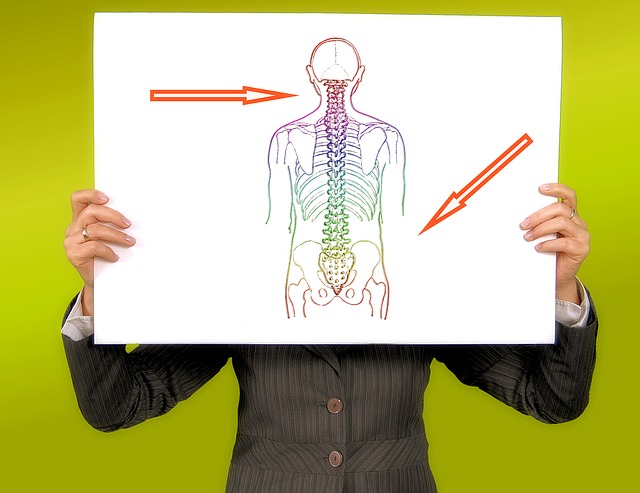A bulging disc at L5/S1 is an extremely common problem. So common, in fact, that 90% of people who suffer from a disc problem will have a bulging disc at this level. Today, we’re going to talk about what a bulging disc at L5/S1 is, the symptoms someone with this problem might get and the ideal treatment to get it better as fast as possible!
What is a Bulging Disc L5/S1?
When we refer to a bulging disc L5/S1, we are talking about a problem with the spinal disc at the lowest level in the spine.
To understand this better, let’s talk a bit about the anatomy of the spine. Once you can picture the area of the body affected by a bulging disc L5/S1, you’ll be able to understand why you’ve got your symptoms and what to do about it!
Before we dive in, please be aware that we are part of the Amazon Affiliate programme. This page may contain Amazon affiliate links, so if you choose to purchase a product for your sciatica that we recommend through a link on this page, we will receive a small commission at no extra cost to you. This helps us keep Overcome Sciatica alive! Thank you for your support. Please be assured that we only ever recommend products that we truly believe can help.
The Human Spine
The human spine is made up of 24 vertebra (your “back bone”) which are funny shaped bones stacked on top of each other. These vertebrae start in the lowest part of your back and run all the way to the top of your neck.
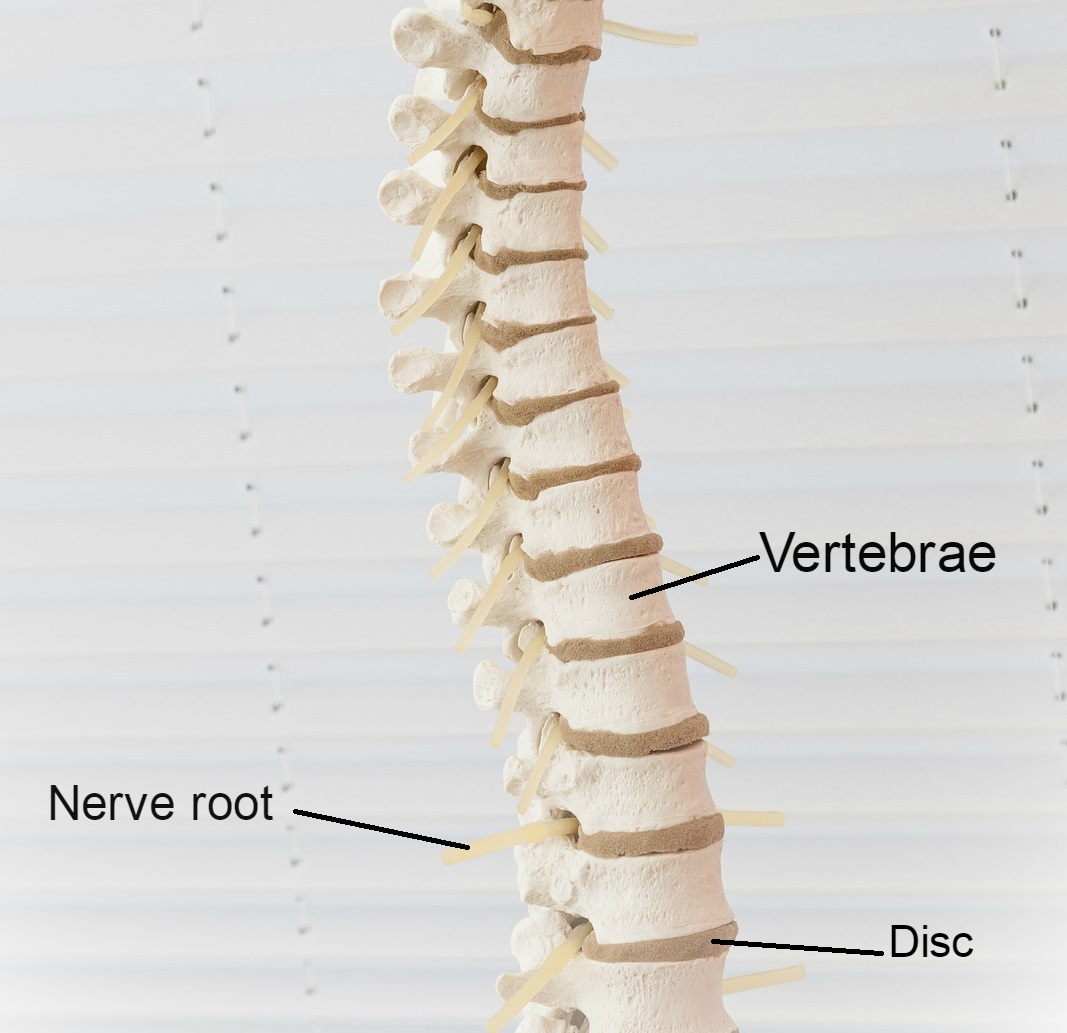
The top 7 vertebrae in the spine are called the “cervical” vertebrae. These make up your neck. We call them C1, C2, C3 etc… All the way down to C7 at the base of the neck.
Your mid-back is made up of the 12 thoracic vertebrae. These are called T1 to T12.
Your lower back is made up of 5 large lumbar vertebrae. These are called L1 to L5. L5 is the lowest vertebra in the spine.
Below that is your sacrum. Your sacrum is the funny shaped bone that joins the right and left parts of your pelvis together. Although the sacrum is one individual bone, there are 4 sets of nerves that exit the sacrum. We call these levels S1-S4.
Below your sacrum is your coccyx – the little bone that forms your ‘tail’!
The Spinal Discs
Between each vertebrae is a spinal disc – a tough sac made up of strong cartilage, filled with fluid.
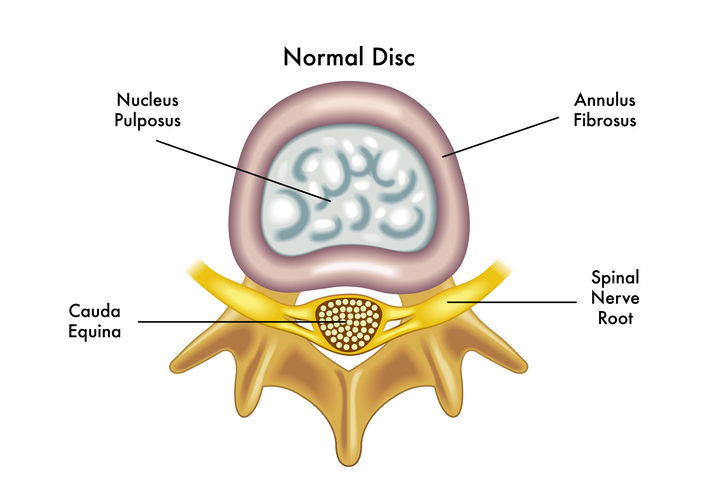
We name these discs based on the vertebrae above and below the disc. For example, if we are talking about the disc between L1 and L2, we would call it disc L1/L2.
So, when we are talking about disc L5/S1, we mean the final disc in the spine that sits between L5 (lowest vertebrae) and the sacrum (S1).
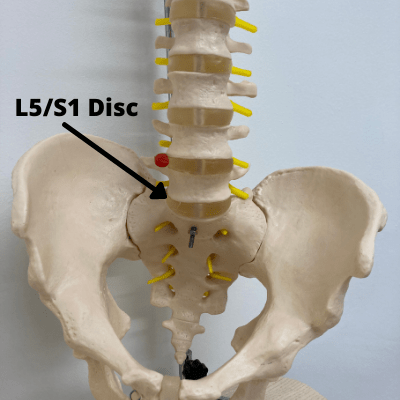
Although the discs are much stronger than a donut, it might help to imagine the design of the discs like a jam donut – made up of tough outer layers filled with fluid.
The discs are very important. They help the spine move normally. Without them, we couldn’t walk, stand or move our spines.
The Nerves and Spinal Cord
Inside the bones in the spine, there is a long hollow passageway. Through this passageway runs the spinal cord, which starts in your brain and runs right down your back – the origin of all the nerves in our body.
From each level in the spine, a tiny portion of the spinal cord splits off and becomes a nerve. This nerve then leaves the spine and runs to a limb or other part of the body.
The nerves are vital to human life – they allow us to move, feel, talk and digest food.
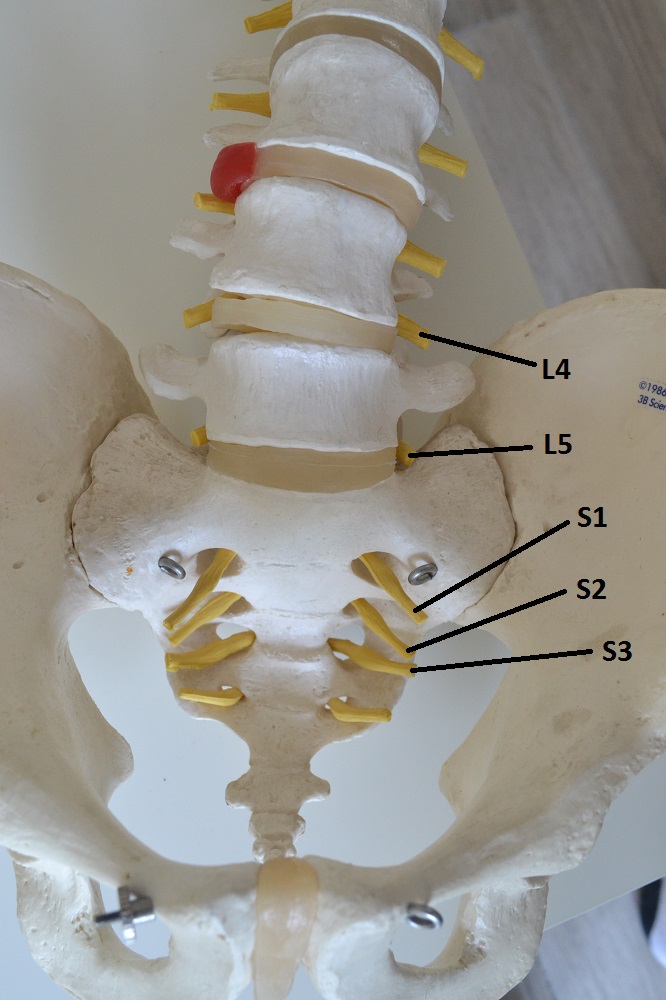
The longest nerve in the human body is the sciatic nerve. It leaves the spine near the bottom of the back and runs all the way down the back of the leg into the toes. It is around an inch in diameter and allows the legs to work normally.
Without the sciatic nerve, you wouldn’t be able to use the muscles in your legs and you would be completely numb in large patches in your legs and feet.
What is a Bulging Disc L5/S1?
Over time, the discs in the spine can suffer normal wear and tear that occurs from repetitive movements throughout our lives. This process happens to everyone and isn’t automatically painful. (Here’s a study that proves this fact.)
However, if one part of the disc has weakened more than others, it can lead to something called a bulging disc.
This describes the event where the strong outer fibres of the disc split (or “herniate”) and the fluid within the disc leaks out at the region where the injury occurred.
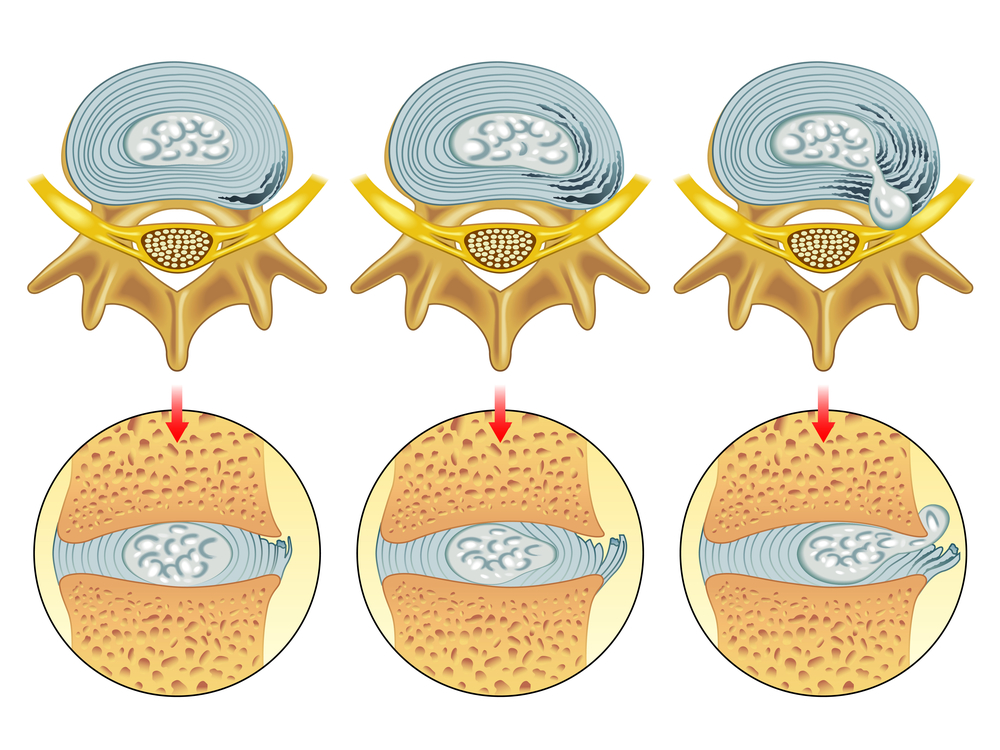
Because of how close the discs are to the nerves within the spine, some of the inner material of the bulging disc can touch the nerve, causing an array of symptoms along the course of that nerve.
If the fluid within the disc touches the sciatic nerve, the symptoms that follow are called “sciatica”.
The term ‘sciatica’ isn’t a disease in and of itself – just a word to describe the symptom of pain in the leg caused by the sciatic nerve.
If someone suffers from a bulging disc at L5/S1, because this disc is extremely close in proximity to the sciatic nerve, the inner material from the disc often touches the nerve and causes sciatica.
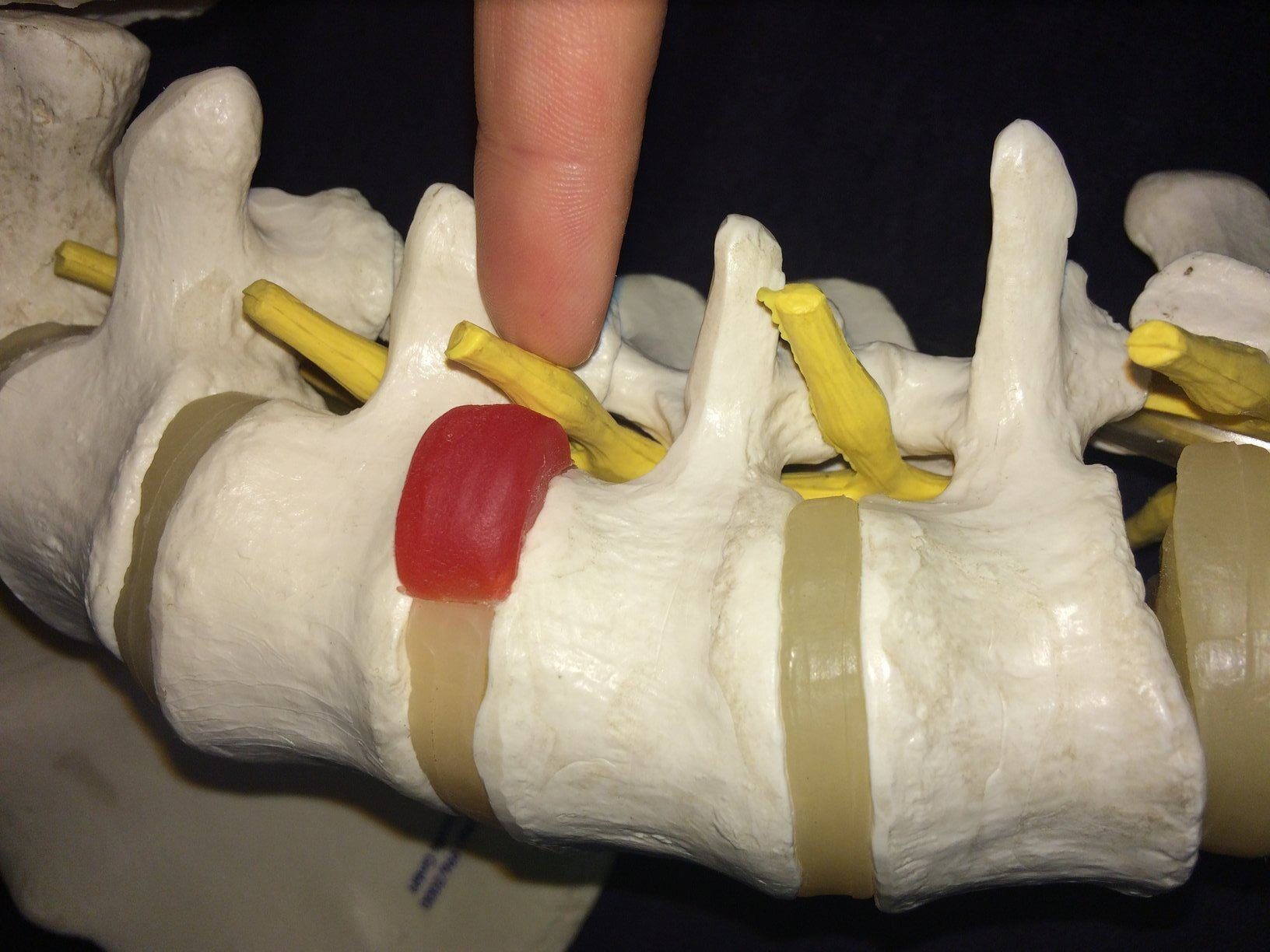
This is why a bulging disc L5/S1 is often one of the most problematic disc issues that someone can experience.
Here is a video describing exactly how a bulging disc causes sciatica:
Why is a bulging disc L5/S1 so common?
We now know that the disc L5/S1 is the lowest disc in the spine. It sits at the junction between the lowest vertebrae and the sacrum.
Because of the way our spines are designed, they have special curves at the top, middle and bottom. When we walk and move, the areas that have a more dramatic curve tend to suffer from more stress than the areas that don’t curve.
In addition to this, the discs that sit at a junction between two different types of vertebrae (i.e. cervical and thoracic (C7/T1) and lumbar and sacrum (L5/S1) tend to suffer even more stress through normal movement.
We think of this as a minor “fault” in the way human spines are created – unfortunately, there isn’t much we can do about this design fault!
Anyway, the disc at L5/S1 is both at the point of a curve in the spine AND at the junction between two types of level. This places it at double the risk of the other vertebra and this is why a bulging disc L5/S1 is so common.
What are the Symptoms of a Bulging Disc L5/S1?
There are a number of symptoms that can occur following a bulging disc L5/S1. They can be alarming and scary for anyone who first experiences them.
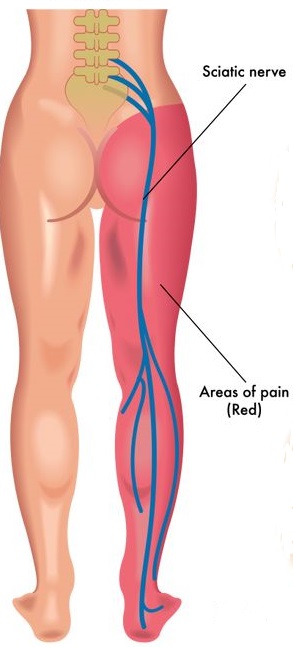
Luckily, with this article, you’ll understand what’s normal and why you are going through these issues which will hopefully alleviate some of your concern.
Common symptoms of a bulging disc L5/S1:
- Back Pain: Perhaps the most common symptom of a bulging disc L5/S1 is back pain. Now, although this may surprise you, not everyone experiences back pain with a bulging disc, but most people do. I was shocked at first when I would get clients who had a bulging disc yet no back pain whatsoever, but it is certainly possible. Most people who suffer a bulging disc L5/S1 will experience an aching to sharp pain right across the lower back. It may be tender to touch and feel like the muscles are in spasm too.
- Sciatica: A bulging disc L5/S1 is the most common cause of sciatica. Sciatica is the word we use to describe the sensation of pain the runs down the back of the leg. It is usually shooting and can be severe – sometimes described by my clients as feeling like “being stabbed by a hot poker”.
- Pins and Needles/Numbness: A bulging disc L5/S1 can cause sensory changes in the leg and foot. Usually, the funny sensations will be present in the foot and toes and for some people this symptom can be worse than the pain. This symptom happens because the bulging disc is pressing against the nerve in the spine which stops the nerve from doing its job correctly. This means that some signals don’t get through properly and sensation isn’t felt normally.
- Weakness in the Legs: Now, this symptom can be alarming and you should definitely head to your doctor if you feel weakness in one or both legs along with any of the other symptoms on this list. Weakness in the legs (particularly calf weakness with a bulging disc L5/S1) indicates a severe nerve compression from the bulging disc. If this sounds like you, it needs addressing as soon as possible.
- No symptoms at all: This is a fact that often shocks people, but most people with a bulging disc L5/S1 will have NO symptoms whatsoever. The symptoms only arise if your bulging disc compresses a nerve – which only happens in some circumstances.
What are the L5-S1 Pain Symptoms and the L5-S1 Pain Pattern?
With a bulging disc at L5-S1, there is often a typical L5-S1 pain pattern. The pattern will depend on whether the L5 nerve root is affected, or whether the S1 nerve root is affected, or both.
The L5 pain pattern involves pain running down the OUTSIDE of the leg to the outer shin and then running to the outside border of the foot.
The S1 pain pattern is more like “classic sciatica” with pain running directly down the back of the leg, often all the way into the toes.
These are the most common L5-S1 pain symptoms.
Uncommon symptoms of a bulging disc L5/S1:
- Leg shaking/spasms: Often confused with sciatica, these spasms cause the muscles to tense up and go into spasm. The best way to deal with this symptom is through a short course of muscle relaxants.
- Problems with the Bladder and Bowel: This is an alarming symptom that needs addressing as quickly as possible by a doctor. This occurs when the nerves that allow the bladder and bowel to do their job are compressed by the bulging disc at L5/S1. If you suffer from incontinence (accidents), not being able to “go” or not being able to feel when your bladder/bowel are full, you need to speak to your doctor as soon as you can. If you cannot contact your doctor, a trip to the emergency room should be your next step.
- Numbness in the Private Areas (or “Saddle” Region): This is another symptom that needs immediate investigation. Again, this indicates the lower nerves are compressed to the point that they can’t function properly. If this isn’t fixed soon, you might end up with a permanent problem. Again, a trip to the emergency room should be your next step.
What are the L5-S1 Disc Herniation Symptoms?
The symptoms of an L5-S1 disc herniation are the same as an L5-S1 bulging disc, listed above – the severity of the symptoms do not reflect the severity of the disc injury, necessarily.
What to Expect from a Bulging Disc L5/S1
When I worked in professional football, we would usually be able to tell the manager with reasonable accuracy exactly how long a player would be out for, depending on the injury he had.
For example, a mild ankle sprain would almost always be recovered by 3 weeks, while a hamstring injury might take 6 weeks.
However, with a bulging disc L5/S1, it isn’t possible to accurately predict how long someone will suffer for.
Almost always, the healthier you are in general, the faster you will get better.
Age also plays a role – people under 40 tend to recover a bit quicker than those over 40. However, other than that, bulging disc recovery time is difficult to predict. You can read more about bulging disc recovery time in this article here.
As a general ball-park figure for you, most people SHOULD feel significantly better after 12 weeks following a bulging disc L5/S1.
However, many don’t. And when you’ve been in pain for a long time, the body undergoes some changes which make recovery slower and more difficult.
That’s why ACTION is key – when you make a commitment to getting better, and do all the right things each day, you can usually accelerate herniated disc recovery significantly.
On that note, my good friend, colleague and fellow international sciatica expert, Dean Volk, has a brand new sciatica relief video course available – ideal for anyone suffering who wants to accelerate the healing of a L5-S1 bulging disc.
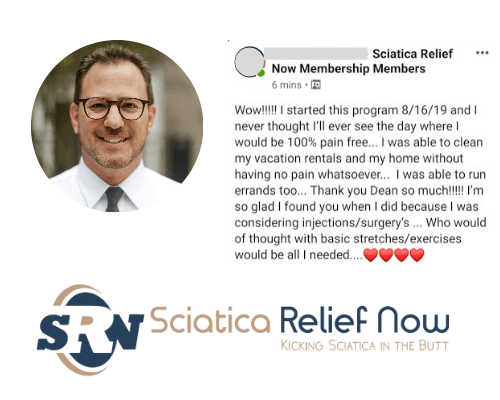
Check out Dean Volk’s “Kicking Sciatica OUT of the Butt!” Online Pain Relief Course Here!
I can proudly recommend Dean and his course for sciatica sufferers – because I’ve seen his incredible results first-hand. You can check out his course (and get lifetime access to the videos and bonus content) by clicking HERE.
L5-S1 Disc Bulge Recovery Time
Day 1 – Day 14
- Expect to be in a LOT of discomfort. Even though staying active as much as possible is key, you’ll need plenty of rest… And that is OK!
- You’ll need to look at HOW the problem started – were you lifting and shifting with poor technique? You’ll need to address this later in the process.
- How’s your diet and sleep? The more sleep you get and the “cleaner” you eat (click HERE for info on the RIGHT foods to eat), the faster you’ll get better from here.
- You may need a short course of pain killers to get through the worst bit.
- It’s worth getting an assessment from a doctor, especially if you are worried about any of your symptoms.
Day 14 – Day 28
- The pain may have started to ease a bit by now, but you’ll likely have incredible stiffness in the lower back. We need to start addressing that soon!
- This is the stage where gentle movement is key – in the back, in the leg and getting out for a few walks if you can manage.
- Make sure to stay hydrated here – when you aren’t fully hydrated, the discs don’t function or recover as well. Drink more water than usual.
Day 28 – Day 56
- Keep going with your rehab, keep walking as much as you can.
- Start a stretching program for your legs – click for a simple stretching program you can use for sciatica relief at this stage.
- Now’s a good time to address the problem that caused the bulging disc at L5/S1 – was it weakness in your back? Was it terrible technique? Was it your lifestyle and the fact that generally you’ve been unhealthy? Start addressing these things now.
- Click here for a complete program that can help you address all the above and get back to normality!
Day 56 – Day 90
- Now, you should start to be getting back to some normality, although you’ll still be feeling fragile.
- You’ll need to take things easy – don’t rush back to anything. You should have someone who can help you at work when the pain starts to nag.
- Don’t worry if you get occasional bad days – it’s normal! Recovery is hardly ever straightforward and few set backs aren’t uncommon.
- Keep addressing the problem areas. If it’s weakness in your spine, you need to strengthen it. Don’t try and do this without guidance! Find a professional or invest in a proven system that works!
Tip: Here is a video that reveals the key signs to indicate that a bulging disc L5/S1 is healing:
Treatment for a Bulging Disc L5/S1
So, when we talk about treatment for a bulging disc L5/S1, we need to split this category into two parts: Lifestyle and Exercise.
With a bulging discs, treatment should always be guided by a qualified healthcare professional, due to the complexities of the injury. The following should not be taken as medical advice, rather as a rough guide to what I find has worked as the most effective treatment for a bulging disc.
In the following video, I’ll show you 8 strategies to speed up recovery from a bulging disc:
Treatment for a Bulging Disc L5/S1 Part #1 – Lifestyle
Diet
Not many people think of diet as an important aspect of recovery from a bulging disc, but it plays an important role. It’s crucial that a diet is optimised for a recovery from a bulging disc L5/S1.
This involves maximising anti-inflammatory foods: click HERE to learn more about anti-inflammatory foods for a bulging disc L5/S1.
You’ll also need to minimise pro-inflammatory foods: click HERE to learn about which foods to AVOID when you have a bulging disc L5/S1.

General Activity
Most people do best when they keep generally active after a bulging disc L5/S1. This means not taking too much time off work.
Most people should try to walk as much as they can within the realms of comfort. The best advice is to stop when pain starts, have a break, then get back to it.
One of my clients with a bulging disc used to leave his house, walk up the road 100 yards, then come back. That was it for each day. But even those few hundred steps made a huge difference over a number of weeks.
Little and often is key – don’t overdo it. I tell my clients to stop as soon as the pain starts to worsen. Each day, they should be able to build their activity levels gradually.
Hydration
Drinking plenty of water is absolutely crucial. When you have a bulging disc L5/S1 compressing a nerve, any dehydration in that disc will make the compression worse.
This means that drinking 3-4 litres of water each day is critical to success and a highly undervalued facet of recovery.

Sleep
Getting as much sleep as possible is incredibly important when you have a bulging disc L5/S1 (although, sciatica can make sleep more difficult, unfortunately).
Sleep is one of the key parts of a recovery from a bulging disc L5/S1 – sleep is when healing occurs. It’s nearly impossible to get better without ample sleep each night.
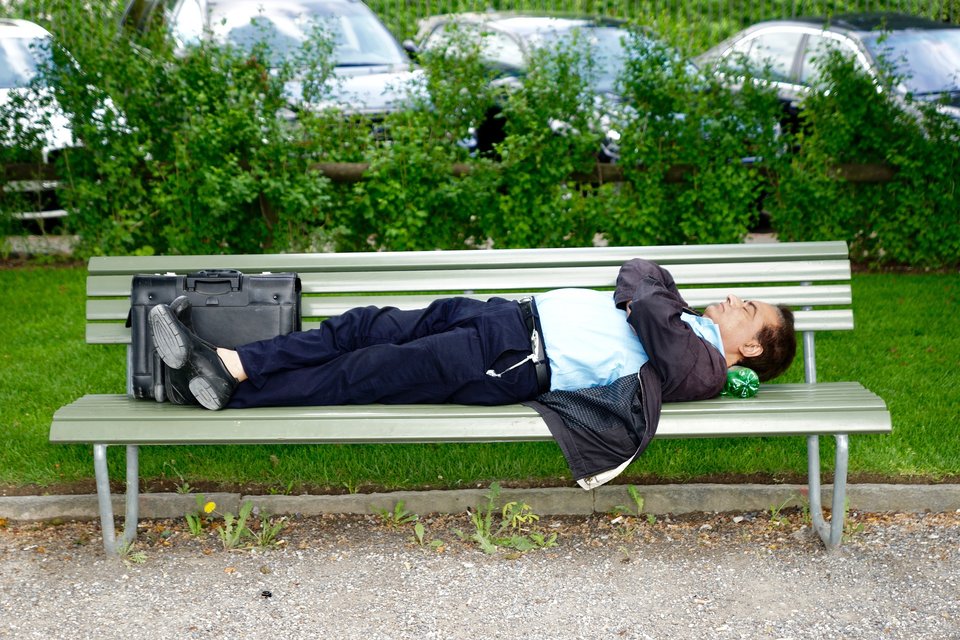
One helpful tip to remember is that you can make up for lost hours of sleep with a nap if your pain tends to be worse at night. A 20-minute nap has been shown to be as effective as two hours of extra sleep in the morning in terms of restoration, some research shows.
Click HERE for a brief guide on sleeping better when you have sciatica.
Minimising Discomfort to Speed Up Recovery
Getting better from a bulging disc L5/S1 is just as much about avoiding making the problem worse as it is about doing extra things.
As a general rule of thumb, if an activity or position is making the pain worse, it is wise to change it – or you run the risk of delaying your herniated disc recovery time.
Products That Can Help
For a bulging disc L5/S1, there are a number of products that can help to improve pain and increase comfort. Here are a few of my top recommended products for L5/S1 bulging disc relief:
#1 – TENS Machine for bulging disc L5/S1
TENS machines are useful for providing relief from pain and muscle spasms in the back and legs. They are a safe and effective way of relieving symptoms without any effort.
Below are 3 of my top recommended TENS machines for relief from a bulging disc L5/S1:
TENSCare Perfect TENS Pain Relief Machine


This TENS machine for herniated disc L5/S1 has 8 preset programs so you don’t need to “tune it” yourself – just pick a setting and off you go! There is an option to purchase a ‘Value Pack’ which includes spare pads which I would definitely recommend.
Click HERE to view the TENSCare Perfect TENS Pain Relief Machine on Amazon US (closest match)
Click HERE to view the TENSCare Perfect TENS Pain Relief Machine on Amazon UK
TPN 200 Plus TENS Machine


A super-simple yet sleek design, this TENS machine is perfect for those who want a highly effective model and are confident with using a TENS machine for bulging disc L5/S1 pain relief. This unit doesn’t have a fancy display, so you can customise the settings to best suit your needs, tweaking and changing the frequency until you find one that works best for you.
Click HERE to view the TPN 200 Plus TENS Machine on Amazon UK
Click this link here to read about our 10 Best Recommended TENS Machines for Sciatica!
#2 – Lumbar Roll
A lumbar roll is a specially designed cushion that goes behind your lower back when sitting.
It increases the curve in the lower back, which many people find takes pressure off a bulging disc L5/S1 when sitting (which can be the worst position for a lot of people).
Here is a great option for a lumbar roll for the office, car and home:


Click HERE to view the Supportiback® Posture Therapy Lumbar Support Cushion on Amazon
#3 – Topical Creams for Pain Relief from Bulging Disc L5/S1
There are a number of topical rubs and creams that can help to relieve pain from a bulging disc L5/S1. In this section of the article, I’m going to share with you which products I believe to be the best creams for bulging disc L5/S1 pain relief.
Always consult your doctor before starting any new medication, including creams.
Best Cream for Bulging Disc L5/S1 Pain – Voltarol


Click HERE to view Voltarol cream for sciatica pain relief Amazon US
Click HERE to view Voltarol cream for sciatica pain relief Amazon UK
This product contains an anti-inflammatory that helps to calm any inflammation around the affected nerve root when someone is suffering from a bulging disc L5/S1.
What’s more, it also contains a natural product that will help to relax hyper-tense muscles and reduce pain, as well as provide a soothing effect to the area. For this reason, I would place it as my go-to and best cream for sciatica pain relief from a bulging disc L5/S1.
Second Best Cream for Bulging Disc L5/S1 Pain – 5Kind Hemp Active Gel


View this product on Amazon here
Hemp-based products have grown in popularity over the last few years. I always keep a close eye on the research regarding hemp and CBD – and the research shows mixed results.
Anecdotally, I’ve heard great things from users of hemp gel as a cream for sciatica pain relief from a bulging disc L5/S1, and I had one client that used it to relieve back pain to great effect.
The product shown is one of the best on the market right now with over 11,000 ratings and an average of 4.5/5 stars!
Third Best Cream for Sciatica Pain Relief from Bulging Disc L5/S1 – FourFive CBD Muscle Rub

Click HERE to view this cream for sciatica pain relief on Amazon
I was never convinced by the CBD craze when it all began, but I am starting to see more compelling evidence for its use in some people, in some cases.
While I don’t believe CBD to be “magic”, I do feel this product has potential to relieve some of the muscle pain experienced in the lower back for many people with sciatica.
That is why this product makes it onto the list of the best creams for sciatica pain relief from bulging disc L5/S1. Check out the reviews of this product – they are really outstanding, with a perfect 5-star rating.
What Other Products Can Help for Bulging Disc L5/S1 Relief?
I’m a big believer in the power of improving your general health when it comes to finding bulging disc L5/S1 pain relief.
If you’re struggling with your mobility due to a bulging disc L5/S1, one thing that might help is to address other general health issues like your weight, your diet and your general exercise.
If you’d like some tips on how to improve all of those aspects of your health, stave off injury and treat problems like bulging discs, why not grab a copy of my brand new book, Thriving Beyond Fifty? You can see more details below:
Top Tip: Grab a copy of my #1 Best-Selling book, Thriving Beyond Fifty for more health, wellness and recovery strategies!
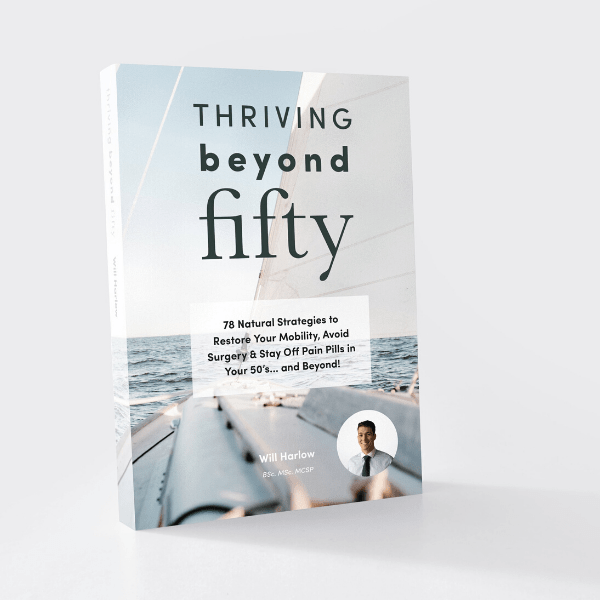
Bulging Disc L5-S1 Exercises
The most important thing to understand when it comes to herniated discs and exercise is that everyone is different; a suitable exercise regime for one person with a bulging disc L5/S1 will be different for another with the same problem.
However, there are some exercises that are commonly useful for many people with herniated discs.
The following list is not a “prescription” because some of these exercises are likely to be unsuitable for you. They are just suggestions of some which have worked for bulging disc L5/S1 relief in the past for my clients.
Never try an exercise that makes your pain feel worse. Always go gently at first and build up slowly. Check with your GP before starting any new exercise programme.
The exercises provided on this page for informational purposes only and are not designed to be a ‘prescription’ of any kind. Be sure to check with your healthcare provider before you begin any new exercise programme.
#1 – Cobra Pose
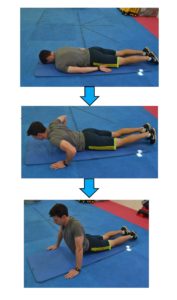
Instructions:
- Begin laying face-down on a firm surface like a mat on the floor or a hard mattress
- Place your hands in line with your shoulders and gently push up, raising your torso off the floor
- Keep your hips down on the floor
- Only go as far as is comfortable – no need to get to full extension for a benefit!
- Gently lower yourself to the starting position and repeat up to a maximum of 10 times.
- Do a set of these 3-4 times per day
Who this is for:
Usually, people suffering with a bulging disc find this exercise one of the most useful for improving their symptoms. However, regardless of what is causing your sciatica, you should only persist with this exercise if it is comfortable to perform this movement. This exercise is a good place to start for those who have trouble bending forward.
Why this exercise works:
This sciatica exercise works because it involves movement of the lower back which encourages blood to flow to the injured area so healing can occur. Some researchers also believe this exercise causes a disc bulge to “centralise” into the disc where it can’t pinch on a nerve root.
#2 – Knee Rolls
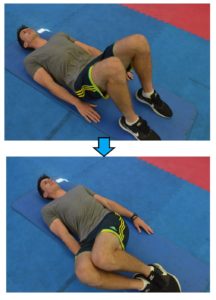
Instructions:
- Lie on your back on a mat or a firm mattress
- Bend your knees up halfway
- Slowly and gently, allow both knees to roll over to one side only as far as is comfortable
- Bring your knees back to the start position, then allow them to roll over to the opposite direction
- Repeat for 30-seconds total, don’t rush the repititions and try to find a rhythm
- Try to find time to do this exercise every 2-3 hours if you can
Who this is for:
This bulging disc exercise is great for relieving any tension in tight muscles in the lower back. It is also a great way to begin to regain any lost rotation in the lower back following a bulging disc.
Why this exercise works:
By gently encouraging a slow, controlled rotation of the lower back, the muscles in your lower back will realise that it is OK to relax a little. This will bring about herniated disc pain relief.
#3 – McKenzie Side Bends

Instructions:
- Start standing next to a wall. Most people prefer to do this exercise with their painful leg being the one FURTHEST AWAY from the wall. However, try both sides and see which one is most comfortable for you – stick with that one.
- Use your elbow and forearm to support yourself so you are leaning on the wall (1st picture)
- Slowly and gently, let your hips “glide” towards the wall while keeping your feet in the same position.
- Only go as far as is comfortable, then return to the start position.
- Repeat this 10 times, have a break, and do 3 sets total.
- If this exercise has worked for you, you may feel rapid relief in the painful leg and possibly slightly worsening back pain – rest assured this is a normal phenomenon.
Who this is for:
This exercise works really well for disc problems and is a mainstay for a treatment approach called “McKenzie”. It brings significant sciatica pain relief to many people and can work rapidly.
Why this exercise works:
The McKenzie approach claims to work by encouraging the disc material called the “nucleus pulposus” to re-centralise into it’s inner middle. Whether or not this actually occurs hasn’t been proven in scientific literature but I have seen this exercise provide relief for many. Be sure to choose the direction that is least painful when performing this sciatica exercise.
#4 – Standing Extension
Instructions:
- Start standing normally.
- Gently try to lean back. Only go as far as is comfortable.
- If you feel able to, use your hands to provide support in the lower back allowing you to extend further (3rd picture)
- Slowly return to the start position
- Perform up to 10 repetitions, every few hours or so. Cut your set short as soon as you reach the first signs of pain.
Who this is for:
This is a great sciatica exercise for a bulging disc as well. It works especially well for people who have trouble leaning forward and is a more user-friendly/convenient version of #1 on this list. However, I find it to be slightly less effective compared to the Cobra pose as I find people tend to rely more on pelvic rather than spinal movement with this one. You should AVOID this exercise if you suffer from arthritis of the lower back or spinal stenosis.
Why this exercise works:
This exercise works in a similar way to #1 – it involves movement of the lower back, encouraging blood to flow to the injured area so disc healing can occur. This exercise may help a bulging disc to “centralise” into the inner disc where it can’t pinch on a nerve root.
BONUS: Here is another exercise that often helps people with calf pain from a bulging disc L5/S1:
Exercises to AVOID with Bulging Disc L5/S1
It is also important to AVOID certain exercises with a bulging disc L5/S1.
Here is a video I made that reveals the most dangerous exercises with a bulging disc and shows you why you need to avoid them:
We also have an article on activities to avoid with a bulging disc L5/S1. This is ESSENTIAL reading for anyone with this problem. You can find it here.
Other Treatment Options for a Bulging Disc L5/S1
Very rarely, surgery is required for a bulging disc. This intervention is reserved for those who have tried everything else and are still suffering.
It’s important to exhaust all non-surgical methods first, as you can’t reverse a surgery and the results from surgery are often underwhelming. Occasionally, surgery can make someone worse which is obviously devastating to hear about.
Another option includes injections, which can give pain relief down the course of the sciatic nerve. From my experience, these have very underwhelming results for most people. However, they can occasionally be effective.
A safer and more effective option is to start a PROVEN exercise programme, designed specifically for people with bulging discs. For people who are unable to come and see me at my clinic, the exercise programme I proudly recommend is Dean Volk’s online course, which you can read about below:

Check out Dean Volk’s “Kicking Sciatica OUT of the Butt!” Online Pain Relief Course Here!
I can proudly recommend Dean and his course for sciatica sufferers – because I’ve seen his incredible results first-hand. You can check out his course (and get lifetime access to the videos and bonus content) by clicking HERE.
Another option:
Grab a copy of my #1 Best-Selling book, Thriving Beyond Fifty for more health, wellness and recovery strategies!
Click HERE to view the book on Amazon UK!
Click here to view the book on Amazon USA!

The information on Overcome Sciatica should never be used as a substitute for medical advice from a doctor. Never put into action any tips or techniques from Overcome Sciatica without checking with your doctor first. Please see full terms of use here.
Conclusion
I hope you’ve found this article helpful. I think it’s useful to understand exactly why you’re suffering the way you are right now from that bulging disc, so the symptoms make more sense. I also hope you find some of the exercises in this article useful.
Remember, getting better from a bulging disc is just as much about managing your day in a way that doesn’t make the symptoms worse as it is about doing exercises to fix it.
What did you think of this article? Was it useful? Leave me a comment below and let me know!

